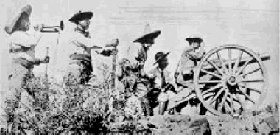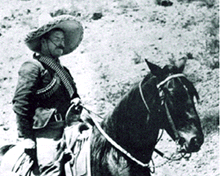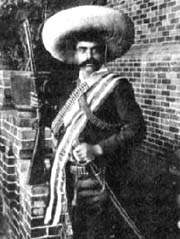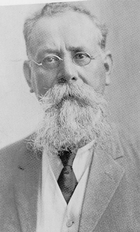Emiliano Zapata, Hero of the Mexican Revolution
Short History of Porfirio Díaz
For most of Mexico's developing history, a small minority of the people were in control of most of the country's power and wealth, while the majority of the population worked in poverty. As the rift between the poor and rich grew under the leadership of General Diaz, the political voice of the lower classes was also declining. Opposition of Diaz did surface, when Francisco I. Madero, educated in Europe and at the University of California, led a series of strikes throughout the country.

Diaz was pressured into holding an election in 1910, in which Madero was able to gather a significant number of the votes. Although Diaz was at one time a strong supporter of the one-term limit, he seemed to have changed his mind and had Madero imprisoned, feeling that the people of Mexico just weren't ready for democracy.
 Once Madero was released from prison, he continued his battle against Diaz in an attempt to have him overthrown. During this time, several other Mexican folk heroes began to emerge, including the well known Pancho Villa in the north, and the peasant Emiliano Zapata in the south, who were able to harass the Mexican army and wrest control of their respective regions. Diaz was unable to control the spread of the insurgence and resigned in May, 1911, with the signing of the Treaty of Ciudad Juarez, after which he fled to France.
Once Madero was released from prison, he continued his battle against Diaz in an attempt to have him overthrown. During this time, several other Mexican folk heroes began to emerge, including the well known Pancho Villa in the north, and the peasant Emiliano Zapata in the south, who were able to harass the Mexican army and wrest control of their respective regions. Diaz was unable to control the spread of the insurgence and resigned in May, 1911, with the signing of the Treaty of Ciudad Juarez, after which he fled to France.
Madero was elected president, but received opposition from Emiliano Zapata who didn't wish to wait for the orderly implementation of Madero's desired land reforms. In November of the same year Zapata denounced Madero as president and took the position for himself. He controlled the state of Morelos, where he chased out the estate owners and divided their lands to the peasants. Later, in 1919, Zapata was assassinated by Jesus Guajardo acting under orders from General Pablo Gonzalez.
 It was during this time that the country broke into many different factions, and guerilla units roamed across the country destroying and burning down many large haciendas and ranchos. Madero was later taken prisoner and executed and the entire country existed in a state of disorder for several years, while Pancho Villa rampaged through the north, and different factions fought for presidential control.
It was during this time that the country broke into many different factions, and guerilla units roamed across the country destroying and burning down many large haciendas and ranchos. Madero was later taken prisoner and executed and the entire country existed in a state of disorder for several years, while Pancho Villa rampaged through the north, and different factions fought for presidential control.
 Eventually, Venustiano Carranza rose to the presidency, and organized an important convention whose outcome was the Constitution of 1917, which is still in effect today. Carranza made land reform an important part of that constitution. This resulted in the
ejido, or farm cooperative program that redistributed much of the country's land from the wealthy land holders to the peasants. The ejidos are still in place today and comprise nearly half of all the farmland in Mexico.
Eventually, Venustiano Carranza rose to the presidency, and organized an important convention whose outcome was the Constitution of 1917, which is still in effect today. Carranza made land reform an important part of that constitution. This resulted in the
ejido, or farm cooperative program that redistributed much of the country's land from the wealthy land holders to the peasants. The ejidos are still in place today and comprise nearly half of all the farmland in Mexico.
Carranza was followed by others who would fight for political control, and who would eventually continue with the reforms, both in education and land distribution. During this period the PRI political party was established, which was the dominant political power for 71 years until Vicente Fox of the conservative PAN party was elected. The holiday itself commemorates the day, November 20th of 1910, when Madero denounced President Diaz, declared himself president of Mexico and called for a national insurrection.